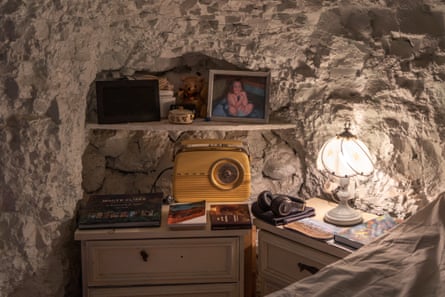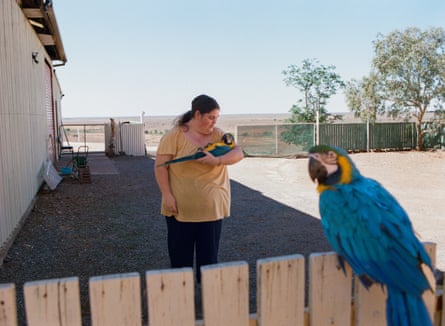Sonia Hyland is underground on a treadmill. There are no windows and no one can hear her blasting Florence + the Machine.
She’s in a dugout, tucked into the cool earth of White Cliffs, a town in remote New South Wales. Outside, the thermometer regularly hits the mid 30s in summer – it once almost hit 50C. But inside these submerged homes, it hovers at about 20 to 22C.
Hyland is one of several locals in this town an hour north of Wilcannia and about three hours’ east of the South Australian border – and who were captured on camera by photographer Marco Serventi.
Maxine Harris poses in a bright pink sunhat against the lumpy wall of her underground home. A group of locals play golf among rocks bigger than the balls. Children perch on the fence of the arena where gymkhanas and rodeos are still held.




“It’s probably the last frontier town in Australia. It’s in the middle of the desert, 300km from the nearest shop and the weather’s beautiful most of the time,” says Tallon Towers, who also lives in White Cliffs.

An ‘earthly maze’
White Cliffs was once an opal mining mecca. Now, a handful of people still try to eke a living from the glittering gemstones. Others depend on the tourists who come to stay in rooms hewn with mining equipment from the stone.
From above, the mining pit craters look like clusters of alien seeds or eggs, white against the red earth. Unsealed tracks wend their way back to the tiny town.
Once upon a time, Bert Gale says, he made the “fatal mistake” of going out with some miners while visiting White Cliffs. He got opal fever and stayed.

“It’s very addictive,” he says.
“You move a lot of rock and dirt and when you do strike opal, it’s the most lovely thing, it’s like a treasure hunt.
“It flashes at you. When it’s in the wall, when you break the rock or dirt and it flashes at you with the bright lights on it. It’s one of god’s treasures, buried for millions of years.”
Opals are found in Cretaceous-age sandstones and mudstones, where silica is released from rocks into the groundwater. That silica-laden groundwater hardens into a gel, then rainbow-flecked opal. In Australia, opalised animal and plant fossils have been found – such as Eric the pliosaur.


-
Hiedee Harris, 20, plays with her two blue-and-yellow macaws in front of her dugout. Children playing outside
Gale now lives in a dugout called Elsewhere. In a poem, he describes it as an “earthly maze” made from reshaped mining shafts and tunnels.
“Inside at night when lights are off, your nose in front can’t see/No sound you hear, no, none at all! Existing peacefully!” he writes.
‘I decided to stick it out’
Towers, one of the few professional opal miners left, heads out to the mines a couple of days a week.
He’s looking for pineapple opals, where the geometric structures radiate outwards like the segments of the tropical fruit. They can be worth tens of thousands of dollars, and they’re only found in White Cliffs.

“I have a favourite one, which is four different types of stones,” Tallon says.
Tallon’s girlfriend, Liz Welsh, joined him in White Cliffs last year. The pair are planning to stay.
He describes storms that last for 24 hours, storms that are horizontal “whirly whirlies” – also known as dust devils or twisters. It can be “like the apocalypse”, he says.
For Welsh, the best thing is star gazing in the middle of the desert, with no ambient light to dim the show.

Hyland had packed up her Brisbane life and was tootling around the outback when the Covid pandemic started. “I got as far as White Cliffs,” she says.
“I like the peace and the tranquility, the friendly people. I thought I’d stay for a wee bit. I decided to stick it out.”
She says some can’t cope with the dust and the isolation, but others just fall in love with the place. The locals gather at the pub – a classic country multi-purpose hotel turned motel turned bar – in the evening for a natter on the veranda, she says.

People pitch in, help each other out, drop by for a chat and a cuppa, and look for opals.
“We go out for a noodle on the field … put together our jars of bright, shiny rocks,” Hyland says. “It’s a nice, peaceful thing to do.”

